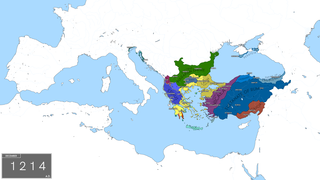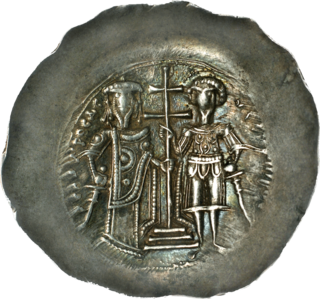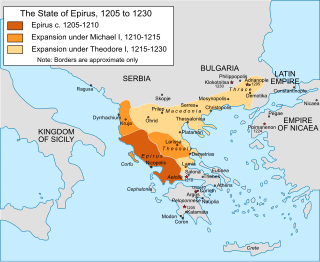
Year 1261 (MCCLXI) was a common year starting on Saturday of the Julian calendar.

Michael VIII Palaiologos or Palaeologus reigned as Byzantine emperor from 1261 until his death in 1282, and previously as the co-emperor of the Empire of Nicaea from 1259 to 1261. Michael VIII was the founder of the Palaiologan dynasty that would rule the Byzantine Empire until the Fall of Constantinople in 1453. He recovered Constantinople from the Latin Empire in 1261 and transformed the Empire of Nicaea into a restored Byzantine Empire. His reign saw considerable recovery of Byzantine power, including the enlargement of the Byzantine army and navy. It also included the reconstruction of the city of Constantinople, and the increase of its population. His re-establishment of the University of Constantinople contributed to the Palaeologan Renaissance, a cultural flowering between the 13th and 15th centuries.

Baldwin II, also known as Baldwin of Courtenay, was the last Latin Emperor ruling from Constantinople.

The Latin Empire, also referred to as the Latin Empire of Constantinople, was a feudal Crusader state founded by the leaders of the Fourth Crusade on lands captured from the Byzantine Empire. The Latin Empire was intended to replace the Byzantine Empire as the Western-recognized Roman Empire in the east, with a Catholic emperor enthroned in place of the Eastern Orthodox Roman emperors. The main objective of the Latin Empire was planned by Venice, which promoted the creation of this state for their self-benefit.

The Empire of Nicaea or the Nicene Empire was the largest of the three Byzantine Greek rump states founded by the aristocracy of the Byzantine Empire that fled when Constantinople was occupied by Western European and Venetian armed forces during the Fourth Crusade, a military event known as the Sack of Constantinople. Like the other Byzantine rump states that formed due to the 1204 fracturing of the empire, such as the Empire of Trebizond and the Despotate of Epirus, it was a continuation of the eastern half of the Roman Empire that survived well into the medieval period. A fourth state, known in historiography as the Latin Empire, was established by an army of Crusaders and the Republic of Venice after the capture of Constantinople and the surrounding environs.
The Battle of Pelagonia or Battle of Kastoria took place in early summer or autumn 1259, between the Empire of Nicaea and an anti-Nicaean alliance comprising Despotate of Epirus, Kingdom of Sicily and the Principality of Achaea. It was a decisive event in the history of the Eastern Mediterranean, ensuring the eventual reconquest of Constantinople and the end of the Latin Empire in 1261.

The House of Laskaris, Latinized as Lascaris, was a Byzantine Greek noble family which rose to prominence during the late Byzantine period. The members of the family formed the ruling dynasty of the Empire of Nicaea, a Byzantine rump state that existed from the 1204 sack of Constantinople by the Fourth Crusade until the restoration of the Empire under the Palaeologan dynasty in 1261.
Alexios Komnenos Strategopoulos was a Byzantine aristocrat and general who rose to the rank of megas domestikos and Caesar. Distantly related to the Komnenian dynasty, he appears in the sources already at an advanced age in the early 1250s, leading armies for the Empire of Nicaea against Epirus. After falling out of favour and being imprisoned by Theodore II Laskaris, Strategopoulos sided with the aristocrats around Michael VIII Palaiologos, and supported him in his rise to the throne after Theodore II's death in 1258. He participated in the Pelagonia campaign in 1259, going on to capture Epirus, but his successes were undone in the next year and he was captured by the Epirotes. Released after a few months, he led the unexpected reconquest of Constantinople from the Latin Empire in July 1261, restoring the Byzantine Empire. He was captured again by the Epirotes in the next year and spent several years in captivity in Italy, before being released. He retired from public affairs and died in the early 1270s.
John Doukas Palaiologos was a Byzantine aristocrat, brother to Emperor Michael VIII Palaiologos, who served as the commander-in-chief of the Byzantine army. He played a prominent part in his brother's military campaigns, most notably in the crucial victory at the Battle of Pelagonia, but also in repeated campaigns against Epirus and against the Turks in Asia Minor. He retired from active service after his defeat at Neopatras, and died shortly after.

The Palaiologan army refers to the military forces of the Byzantine Empire under the rule of the Palaiologos dynasty, from the late 13th century to its final collapse in the mid-15th century. The army was a direct continuation of the forces of the Empire of Nicaea, which itself was a fractured component of the formidable Komnenian army of the 12th century. Under the first Palaiologan emperor, Michael VIII, the army's role took an increasingly offensive role whilst the naval forces of the empire, weakened since the days of Andronikos I Komnenos, were boosted to include thousands of skilled sailors and some 80 ships. Due to the lack of land to support the army, the empire required the use of large numbers of mercenaries.
Alexios Doukas Philanthropenos was a Byzantine nobleman and notable general. A relative of the ruling Palaiologos dynasty, he was appointed commander-in-chief in Asia Minor in 1293 and for a time re-established the Byzantine position there, scoring some of the last Byzantine successes against the Turkish beyliks. In 1295 he rose up in revolt against Andronikos II Palaiologos, but was betrayed and blinded. Nothing is known of him until 1323, when he was pardoned by Andronikos II and sent again against the Turks, relieving a siege of Philadelphia, allegedly by his mere appearance. He was then named briefly governor of Lesbos in 1328, and again in 1336, when he recovered the island's capital from Latin occupation. He ruled the island thereafter, probably until his death in the 1340s.

Marie of Brienne was Latin Empress as the wife of Baldwin II of Courtenay. She served as regent during the absence of Baldwin II twice: in 1237–1239, and in 1243–1257.

The siege of Constantinople (1235) was a joint Bulgarian–Nicaean siege on the capital of the Latin Empire. Latin emperor John of Brienne was besieged by the Nicaean emperor John III Doukas Vatatzes and Tsar Ivan Asen II of Bulgaria.

The Treaty of Nymphaeum was a trade and defense pact signed between the Empire of Nicaea and the Republic of Genoa in Nymphaion in March 1261. This treaty would have a major impact on both the restored Byzantine Empire and the Republic of Genoa that would later dictate their histories for several centuries to come.

The siege of Constantinople in 1260 was the failed attempt by the Nicene Empire, the major remnant of the fractured Byzantine Empire, to retake Constantinople from the Latin Empire and re-establish the City as the political, cultural and spiritual capital of a revived Byzantine Empire.
The Gasmouloi or Vasmouloi were the descendants of mixed Byzantine Greek and "Latin" unions during the last centuries of the Byzantine Empire. As the Gasmouloi were enrolled as marines in the Byzantine navy by Emperor Michael VIII Palaiologos, the term eventually lost its ethnic connotations and came to be applied generally to those owing a military service from the early 14th century on.

The Battle of Neopatras was fought in the early 1270s between a Byzantine army besieging the city of Neopatras and the forces of John I Doukas, ruler of Thessaly. The battle was a rout for the Byzantine army, which was caught by surprise and defeated by a much smaller but more disciplined force.

The Battle of Makryplagi or Makry Plagi was fought between the forces of the Byzantine Empire, and the Latin Principality of Achaea. The Byzantines had been weakened and demoralized by the defection of their numerous Turkish mercenaries to the Achaeans. At Makryplagi, the Byzantines suffered a heavy defeat, which together with their defeat at the Battle of Prinitza the previous year ended their attempted reconquest of the Morea.

The Empire of Thessalonica is a historiographic term used by some modern scholars to refer to the short-lived Byzantine Greek state centred on the city of Thessalonica between 1224 and 1246 and ruled by the Komnenodoukas dynasty of Epirus. At the time of its establishment, the Empire of Thessalonica, under the capable Theodore Komnenos Doukas, rivaled the Empire of Nicaea and the Second Bulgarian Empire as the strongest state in the region, and aspired to capturing Constantinople, putting an end to the Latin Empire, and restoring the Byzantine Empire that had been extinguished in 1204.

The Nicaean–Latin wars were a series of wars between the Latin Empire and the Empire of Nicaea, starting with the dissolution of the Byzantine Empire by the Fourth Crusade in 1204. The Latin Empire was aided by other Crusader states established on Byzantine territory after the Fourth Crusade, as well as the Republic of Venice, while the Empire of Nicaea was assisted occasionally by the Second Bulgarian Empire, and sought the aid of Venice's rival, the Republic of Genoa. The conflict also involved the Greek state of Epirus, which also claimed the Byzantine inheritance and opposed Nicaean hegemony. The Nicaean reconquest of Constantinople in 1261 AD and the restoration of the Byzantine Empire under the Palaiologos dynasty did not end the conflict, as the Byzantines launched on and off efforts to reconquer Southern Greece and the Aegean islands until the 15th century, while the Latin powers, led by the Angevin Kingdom of Naples, tried to restore the Latin Empire and launched attacks on the Byzantine Empire.



















